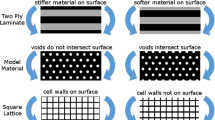Abstract
A number of studies have indicated that imperfections in cellular solids can have a very large influence on their mechanical behavior. Waviness in cell walls can drastically reduce elastic stiffnesses, and various irregularities can reduce the effective strengths by large factors. These imperfections have in many instances been studied in isolation, i.e., only a singe type of imperfection was studied at a time. The goal of the present paper is to shed light on how different kinds of imperfections interact. There is a potential risk that when multiple kinds of imperfections are present, the mechanical properties of the cellular solid are worse than what would be predicted from each one in isolation. The present study is focused on linear elastic properties, although many of the conclusions apply also for other properties. The method employed is based on statistical averages and Taylor expansion arguments. Such techniques have in previous papers been applied to a single imperfection type. The conclusion from the present analysis is that, up to the third order in “small” parameters describing the severity of the imperfections, there is no interaction between a number of different types of imperfections.
Similar content being viewed by others
References
L. J. GIBSON and M. F. ASHBY, “Cellular Solids: Structures and Properties”, 2nd edition (Cambridge University Press, Cambridge, 1997).
J. L. GRENESTEDT, Int. J. Solids Struct. 36(10) (1999) 1471.
Y. SUGIMURA, J. MEYER, M. Y. HE, H. BART-SMITH, J. GRENESTEDT and A. G. EVANS, Acta Mater. 45 (12) (1997) 5245.
J. L. GRENESTEDT, J. Mech. Phys. Solids 46(1) (1998) 29.
A. E. SIMONE and L. J. GIBSON, Acta Mater. 46(11) (1998) 3929.
J. L. GRENESTEDT and K. TANAKA, Scripta Materialia 40(1) (1998) 71.
J. L. GRENESTEDT and F. BASSINET, Intern. J. Mech. Sci. 42(7) (2000) 1327.
W. THOMSON (Lord KELVIN), Phil. Mag. 24(151) (1887) 503.
E. KRÖNER, Zeitschrift für Physic 151 (1958) 504.
Z. HASHIN and S. SHTRIKMAN, J. Mech. Phys. Solids 11 (1963) 127.
“Divinycell, Technical Manual HT Grade” (DIAB, Box 201, S-312 22 Laholm, Sweden, 1992).
“Divinycell, Technical Manual HCP Grade” (DIAB, Box 201, S-312 22 Laholm, Sweden, 1992).
“Divinycell, Technical Manual H Grade” (DIAB, Box 201, S-312 22 Laholm, Sweden, 1995).
K. LI, X.-L. GAO and G. SUBHASH, Intern. J. Solids Struct. 42 (2005) 1777.
S. RIBEIRO-AYEH, Finite Element Modelling of the Mechanics of Solid Foam Materials, PhD. Thesis, ISBN 91-7178-002-5, Royal Institute of Technology, Dept. of Aeronautical and Vehicle Eng., S-100 44 Stockholm, Sweden, 2005.
Author information
Authors and Affiliations
Corresponding author
Rights and permissions
About this article
Cite this article
Grenestedt, J.L. On interactions between imperfections in cellular solids. J Mater Sci 40, 5853–5857 (2005). https://doi.org/10.1007/s10853-005-5019-4
Received:
Accepted:
Issue Date:
DOI: https://doi.org/10.1007/s10853-005-5019-4




